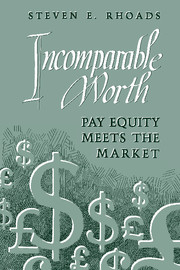Book contents
- Frontmatter
- Contents
- Acknowledgments
- 1 Introduction
- 2 The debate over equal pay for comparable worth
- 3 Implementing comparable worth in Minnesota
- 4 Job evaluation in Minnesota localities
- 5 Equal pay for work of equal value in the European Community
- 6 Equal pay for work of equal value in the United Kingdom
- 7 Equal pay for work of equal value in Australia
- 8 Conclusion
- Appendix: a note on the research and presentation of findings
- Notes
- Index
2 - The debate over equal pay for comparable worth
Published online by Cambridge University Press: 06 July 2010
- Frontmatter
- Contents
- Acknowledgments
- 1 Introduction
- 2 The debate over equal pay for comparable worth
- 3 Implementing comparable worth in Minnesota
- 4 Job evaluation in Minnesota localities
- 5 Equal pay for work of equal value in the European Community
- 6 Equal pay for work of equal value in the United Kingdom
- 7 Equal pay for work of equal value in Australia
- 8 Conclusion
- Appendix: a note on the research and presentation of findings
- Notes
- Index
Summary
As explained in Chapter 1, full-time working women get only $.71 for every dollar received by full-time working men. Supporters of comparable worth know that few years have passed since separate want ads for men and women restricted options for working women. They also know that surveys show that many managers think men more likely than women to have the traits thought to be associated with managerial effectiveness. They cite court cases showing that some major firms continue to restrict women's access to jobs and promotions. And they endorse and publicize an influential report of the National Academy of Science's National Research Council which concludes that a substantial portion of the wage gap results from sex discrimination.
Comparable-worth advocates are outraged that male animal-care attendants get paid more than female child-care workers, and male high school graduates more than female college graduates. They argue that remedying such discrimination is efficient as well as fair since “resources aren't reasonably allocated when some people are underpaid and others are overpaid, relative to their contribution to the employer.” Moreover, at a time when so many families are dependent on women's income, underpaying women is considered a cause of poverty and other social ills.
- Type
- Chapter
- Information
- Incomparable WorthPay Equity Meets the Market, pp. 7 - 40Publisher: Cambridge University PressPrint publication year: 1993



